A local company expanding across Canada will continue to call Nanaimo home.
Atlas Engineered Products is setting up its head offices in north Nanaimo. The move comes after it became a publicly traded company and began rapid incursions into construction markets in Ontario and Manitoba.
Atlas Engineered Products started out as a small roof truss manufacturing operation in South Wellington that was purchased by Hadi Abassi in 1999.
“It had a revenue of just under $100,000 per year and it came with two and a half employees,” Abassi said.
The assembly plant is now located on Boxwood Road and just one of a network of several construction component prefabrication plants within six companies in B.C., Ontario and Manitoba brought together by AEP since the beginning of 2018.
Prefabrication offers advantages over conventional “stick construction” where walls, floors and other components are assembled on site. Building components, assembled in indoor fabrication plants, unaffected by winter weather that can shut down work, that utilize precision computer-controlled laser cutting and other manufacturing tools can increase speed and accuracy in production and cut material waste and costs.
“It’s not just walls. It’s trusses, walls, floors, it’s everything,” Abassi said. “You can put out a whole building envelope. You can build inside the plant and ship it off to the job site and put it together in less time, three or four days.”
If a developer wants to create, for example, a townhouse complex, plans are sent to the prefabrication plant, the building envelope components are made according to the order and then shipped to the job site for assembly.
“The idea of the prefabricated structural components has always been there and it’s huge in Europe especially because the technology there is always ahead,” Abassi said.
Combining the latest construction materials with faster on-site assembly can also make homes less expensive to produce and more affordable for buyers.
“In London, Ont., we do the walls, the floors, we do the roofs. We do everything,” he said. “One of the last major projects we did was a hotel in Michigan. We ship to the U.S. and that was a five-storey building. We did the roof, the walls, everything for that.”
Plants can be tailored to serve specific markets. A factory in Ontario manufactures for a market where commercial agriculture buildings are in high demand. The Nanaimo plant, which currently builds roof trusses, floors and windows, will soon get the wall fabrication system as well. Abassi said some markets are already well acquainted with using prefabricated building components, such as Michigan and New York, whereas other areas including Manitoba and Nanaimo need to be introduced to the concept.
Becoming a publicly traded company allowed AEP to start acquiring other companies and consolidate and strengthen a “fragmented” industry into a nationwide manufacturing network.
“Before that I had an idea there was an appetite across the country for consolidation because we are a very fragmented industry and we are right for consolidation and we were the first company that actually did that and there’s lots of opportunities there,” Abassi said.
Abassi, whose company’s expertise is in manufacturing, admitted it had no idea about the public market, but his staff set out to learn the ropes and forged ahead until last fall when Atlas hired Dirk Maritz as CEO and president.
“Since he’s been on board … as a company, we have moved leaps and bounds and we’re moving forward surely, but fast,” Abassi said.
Maritz said AEP’s success is based on the depth and breadth of talent that has been gathered into the company.
“The strongest assets by far are the quality of people that we employ in this business,” Maritz said. “For example, you see people who have worked 20, 30, 40 years in our strong regional businesses. That experience; those are the relationships you can’t buy. I can go and buy equipment. I cannot buy the combined skills of the people that we have in this organization and that is why we’re successful.”
On Nov. 8, Maritz reported AEP had experienced its second consecutive quarter of positive net income since it went public in 2017 and positive net income for the nine months that ended Sept. 30, and overall revenue of more than $10.4 million and $25.7 million respectively, up from more than $5 million and $11 million for the three and nine months ending Aug. 31, 2018.
“It’s not so much bragging about it as sharing about it, what’s happening with Atlas,” Abassi said. “It all started in Nanaimo and it’s always going to be be a Nanaimo company.”
photos@nanaimobulletin.com
Like us on Facebook and follow us on Twitter
